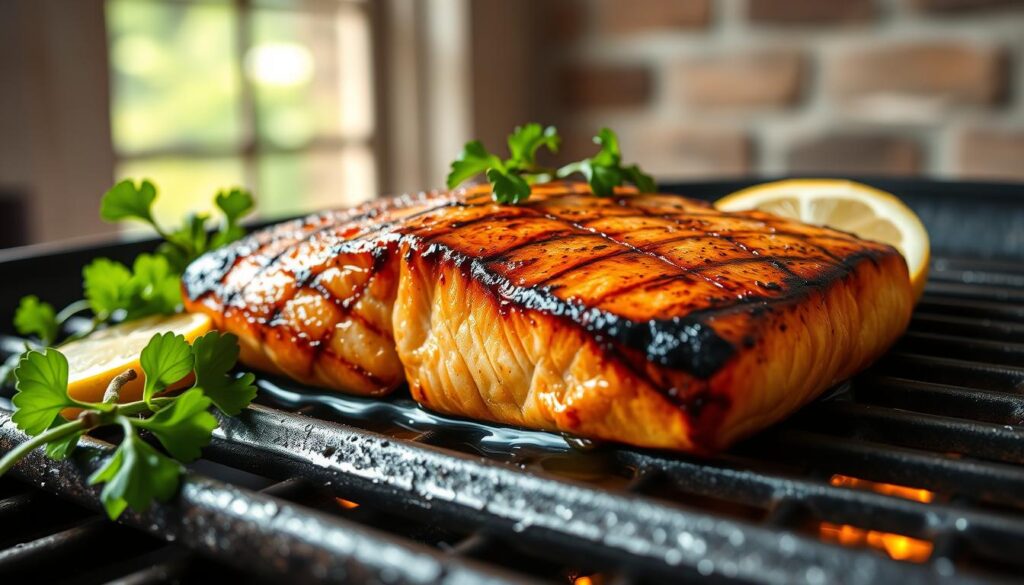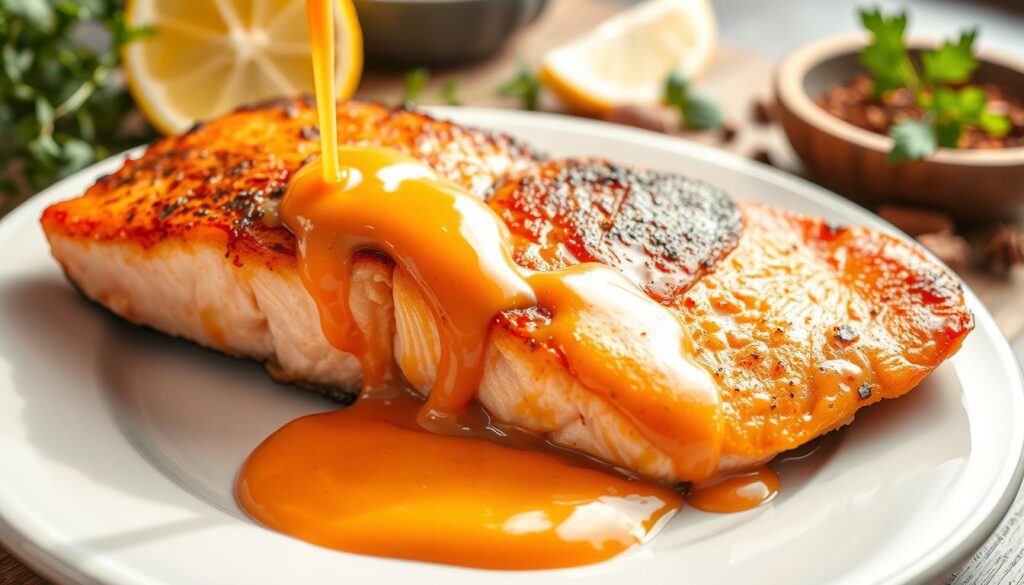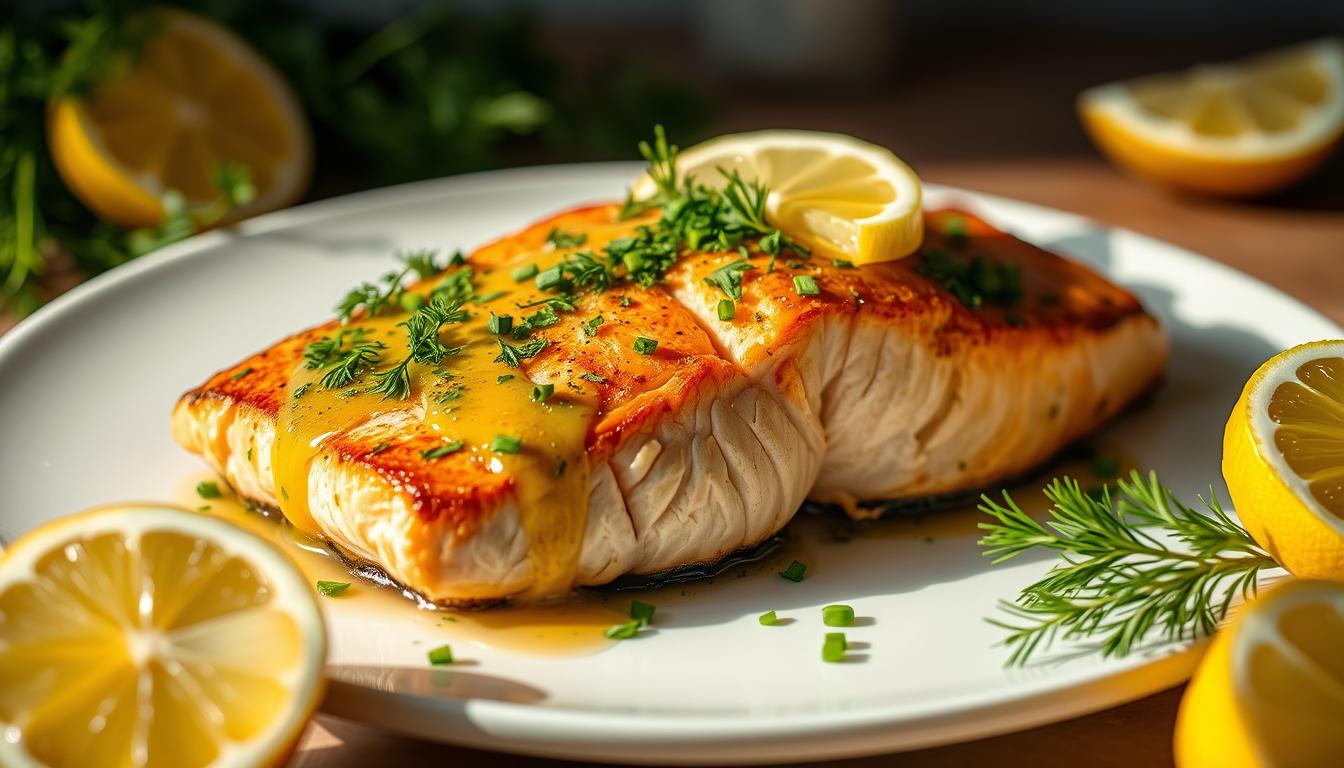There’s a moment in every cook’s life when a recipe becomes more than food—it becomes a memory. For me, that happened on a misty morning in Alaska. My mom was searing salmon steaks over a campfire, and their edges were caramelizing into crisp perfection. That dish wasn’t just dinner; it was the start of a lifelong love affair with salmon’s bold, buttery flavor.
Now, I’m sharing how you can recreate that magic at home with our best salmon steak recipe. It’s as simple as it is delicious.
Table of Contents
Key Takeaways
- Quick 15-22 minute meals with minimal prep.
- Rich in protein (23g) and heart-healthy fats (14g).
- Flavor boost from garlic, ginger, and citrus.
- Perfect texture: crispy skin, tender interior.
- Easily adaptable to teriyaki or spicy variations.
Imagine a dinner that’s ready in under half an hour, uses just 7 ingredients, and delivers that “wow” factor every time. This delicious salmon steak recipe does exactly that. Whether you’re grilling, baking, or pan-searing, we’ll guide you through selecting the freshest salmon, mastering cooking temps (120-125°F), and pairing it with zesty sauces. No more dry fish—just flaky, juicy results that satisfy even the pickiest seafood fans.
Why Salmon Steaks Are Perfect for Any Occasion
Salmon steaks are a top choice for any meal. They’re great for a quick weeknight dinner or a special occasion feast. Their rich taste and flexibility make them perfect for your favorite salmon steak recipe. Plus, they’re a smart choice for a healthy salmon steak recipe.
Nutritional Benefits of Salmon
Salmon steaks are packed with nutrients. King salmon, like Copper River King, is high in Omega-3 fatty acids. These healthy fats can help reduce the risk of heart disease, dementia, and arthritis. When you choose a healthy salmon steak recipe, you’re prioritizing your well-being without sacrificing taste.
Difference Between Salmon Steaks and Fillets
- Steaks include the bone and skin, adding flavor and moisture.
- Fillets lack bones, making them thinner and less suited for high-heat cooking.
- Steaks are cost-effective and hold up well in grilling or roasting.
Why Seafood Lovers Prefer Salmon Steaks
Seafood enthusiasts love salmon steaks for their rich flavor and versatility. The skin crisps perfectly on the grill, and the bone adds depth. They’re perfect for methods like sous vide or en papillote. As one fan says:
Salmon is one of my favorites and when I make this salmon steak recipe I know why.
Plus, their thickness allows even cooking, ensuring every bite stays juicy.
Essential Ingredients for the Perfect Salmon Steak Recipe
Every great salmon steak recipe starts with a few key ingredients. These enhance the fish’s natural flavor without overpowering it. Keep it simple to let the salmon shine. Here’s what you’ll need:
- Fresh salmon steaks: Choose 6-ounce portions with bones in for even cooking. Look for firm, shiny flesh with no fishy smell.
- Fat sources: Use olive oil for a light finish or butter for richness. A 2:1 mix of both adds depth.
- Seasonings: Mix ½ tsp kosher salt, black pepper, and optional aromatics like minced garlic or onion powder. Add a dash of Worcestershire sauce for umami.
- Acid elements: Use fresh lemon juice or white wine to balance richness. 1 tbsp lemon juice per steak works well.
- Herbs: Garnish with fresh parsley, dill, or basil. Toss stems into the pan for extra flavor before serving.
A simple salmon steak recipe thrives on quality over quantity. Stick to 5-7 core ingredients, adjusting spices to taste. Pro tip: Marinate with garlic and chili powder for 30 minutes before cooking for extra depth. Let the salmon’s buttery texture take center stage—your taste buds will thank you!
Selecting the Freshest Salmon for Your Dish
Choosing the freshest salmon is key for a great best salmon steak recipe. Look closely at the fish. It should have firm flesh and a bright orange-red color. It should smell like the ocean, not fishy or ammonia-like. Here’s how to pick the perfect cut.
“The best salmon to choose is the King salmon, also known as Chinook. It’s large, rich in Omega-3s, and has bright orange-red flesh with no strange odors.”
How to Identify Fresh Salmon at the Market
- Check the flesh: It should spring back when touched, not stay indented.
- Avoid fish with dry edges, brown spots, or cloudy eyes.
- Opt for flash-frozen salmon if fresh options are limited—quality often matches fresh.
Wild-Caught vs. Farm-Raised Salmon
Wild salmon, certified by MSC or RFM labels, offers rich flavor and sustainability. Farm-raised options can still work if sourced from eco-conscious brands. Compare:
| Wild-Caught | Farm-Rased |
|---|---|
| Deeper color, firmer texture | Softer flesh, milder taste |
| Sustainability certifications preferred | Choose brands with clean feed practices |
Best Salmon Varieties for Steaks
King (Chinook) and Sockeye deliver bold flavor and firm texture. Coho and Atlantic work well too. Avoid pale, flaky fish like Chum for steak cuts.
Remember: Fresher salmon means better flavor. Prioritize sustainability and quality to elevate your best salmon steak recipe every time.
Kitchen Tools You’ll Need for Preparing Salmon Steaks
Learning to cook salmon steak begins with the right tools. Even the simplest recipes need these basics. Here’s what you’ll need:
| Tool | Purpose | Pro Tip |
|---|---|---|
| Chef’s knife | Cutting and portioning | Choose a sharp blade for clean cuts |
| Needle-nose pliers | Removing pin bones | Work carefully under running water |
| Instant-read thermometer | Checking doneness | Target 125°F for medium-rare |
| Cast-iron skillet | Even searing heat | Preheat slowly to avoid sticking |
| Fish spatula | Flipping without tearing | Use wide, flexible edges |
Remember, you’ll also need paper towels for drying and a baking sheet for oven cooking. A splatter screen is great for pan-searing. For marinades, a big container helps with even flavor.
Pro chefs love fish tweezers for grilling. They’re perfect for flipping without breaking the fish. A kitchen scale is key for consistent portions and even cooking times.
Preparing Your Salmon Steak Before Cooking
Before you start how to cook salmon steak, make sure to prepare it right. Take your salmon out of the fridge 30 minutes before cooking. This lets it get to room temperature.
Pat each steak dry with paper towels. This step helps prevent steaming and improves the sear.
Proper Cleaning and Handling
- Check for pin bones by running your fingers over the flesh. Use tweezers to gently pull them out.
- Trim any excess fat or uneven edges for even cooking.
- Wipe the skin side lightly with a damp cloth if needed, then dry again thoroughly.
Marinating Techniques for Maximum Flavor
For a simple salmon steak recipe, marinate 15–30 minutes. Use acidic ingredients like lemon juice or soy sauce. But don’t overdo it, as it can make the flesh soft.
Try this quick blend:
- 1 tbsp olive oil
- 1 tsp minced garlic
- Zest of half a lemon
Quick Dry Rubs That Enhance Natural Taste
| Ingredient | Amount |
|---|---|
| Kosher salt | ½ tsp per steak |
| Black pepper | ¼ tsp |
| Dried sage | ½ tsp |
Massage the rub into both sides. Let it sit for 10 minutes before cooking. Use a cast iron skillet. Preheat it with 1 tsp oil until it’s hot but not smoking.
The Classic Grilled Salmon Steak Recipe
Grilling turns salmon steaks into a smoky, juicy delight. To make the best salmon steak recipe, heat your grill to 450-500°F. Make sure to clean and oil the grates to avoid sticking.
- Marinate salmon in a mix of soy sauce, lemon juice, honey, and minced garlic for 3-24 hours (minimum 1 hour).
- Set up a two-zone fire: one side at high heat (450-500°F), the other medium (350°F).
- Pat salmon dry, place skin-side down on the hot side. Sear 6-8 minutes until caramelized, then flip and finish on the cooler side 2-4 minutes.
- Brush with a melted butter-lemon-garlic glaze during the last 2 minutes for extra flavor.

For even cooking, wrap each steak in foil with butter and herbs before grilling—ideal for thinner cuts.
Let the salmon rest for 2 minutes after grilling. Serve with lemon wedges, scallions, and sides like grilled corn or a crisp garden salad. Aim for an internal temp of 125°F (50°C) for juicy results. Pro tip: Use king or sockeye salmon for firm texture, and always pat the skin dry before grilling for perfect crispiness.
How to Cook Salmon Steak to Perfection
Learn to cook salmon steaks to get a tender and juicy result. Use a thermometer to check the temperature. Aim for 125–130°F (52–54°C) for a perfect doneness. Here’s a simple guide to cooking salmon steaks:
| Method | Time | Temperature | Key Tip |
|---|---|---|---|
| Pan-Seared | 4–6 mins/side | Medium-high heat | Cook skin side first until crispy |
| Oven-Baked | 15–22 mins | 400°F (204°C) | Rest 5 mins post-baking |
| Poaching | 8–10 mins total | Simmering liquid | Check flakiness with a fork |
Pan-Seared Method
- Season steaks with salt, pepper, and spices like paprika or garlic powder.
- Heat oil in a skillet until shimmering. Place skin-side down first. Cook 4–5 mins until golden.
- Flip carefully with tongs and a spatula. Cook 3–4 mins more. Rest 5 mins before serving.
- Finish with a lemon butter sauce: melt butter, mix in lemon juice, and drizzle over the steak.
Oven-Baked Technique
This method is easy and requires little effort:
- Preheat oven to 400°F (204°C). Line a baking sheet with parchment paper.
- Season both sides with a blend of garlic, lemon zest, and herbs like thyme.
- Bake 15–22 mins until internal temp reaches 145°F (63°C). Let rest 5 mins post-baking.
Poaching for Ultimate Tenderness
Poaching makes the steaks tender:
- Simmer water, white wine, or broth with dill and bay leaves.
- Submerge steaks gently and cook 6–8 mins. The flesh turns opaque when done.
- Test doneness by flaking the center with a fork. Avoid overcooking.
Pair any method with lemon wedges and your favorite sides. Remember: remove salmon when it reaches 140°F (60°C) for carryover cooking. Enjoy your perfectly cooked masterpiece!
Easy Salmon Steak Recipe for Weeknight Dinners
Turn busy weeknights into special moments with this easy salmon steak recipe. It’s quick, with just 7 ingredients and cooks in under 20 minutes. Pair it with roasted veggies or a grain for a balanced meal that’s both fast and tasty.
15-Minute Preparation Tips
- Pat salmon dry before seasoning to ensure crispy edges.
- Marinate 30 minutes for deeper flavor, but cook immediately if time is tight.
- Use a baking sheet for one-pan cooking—no need to switch pans!
| Meal Idea | Serving Suggestion |
|---|---|
| Herb-Crry | Top with chives or parsley before serving. |
| Vegetable Pairing | Roast asparagus or broccoli alongside salmon on the same sheet. |
| Quick Sauce | Drizzle with lemon-butter mixture during baking. |
One-Pan Meal Ideas
Pair salmon with these quick sides:
- Quinoa tossed with roasted veggies
- Steamed green beans with lemon zest
- Couscous mixed with cherry tomatoes
| Nutrition Facts | Per Serving |
|---|---|
| Calories | 294 |
| Protein | 31.9g |
| Fat | 18.2g |
| Carbs | 1.7g |
| Sodium | 709mg |
Storage tip: Leftovers keep 3 days in the fridge or freeze up to 2 months. Add paprika or garlic powder for extra flavor!
Delicious Sauce Pairings That Elevate Your Salmon
Make your delicious salmon steak recipe even better with the right sauces. The best salmon steak recipe combines bold or subtle toppings. This balances the richness and texture. Start with a classic lemon butter sauce:

- Combine ¾ cup white wine, 3 Tbsp minced shallot, and 2 Tbsp lemon juice in a saucepan. Reduce heat until mixture reaches ¼ cup.
- Whisk in butter pieces one at a time until smooth. Add dill, salt, and pepper to taste.
- Adjust consistency with cornstarch or broth if needed.
Try these other pairings for variety:
| Sauce | Key Ingredients | Pairing Tip |
|---|---|---|
| Citrus Glaze | Lemon, orange juice, honey, soy sauce | Brush on grilled salmon during last 5 minutes |
| Creamy Dill | Greek yogurt, fresh dill, lemon juice | Serve chilled as a cooling contrast |
| Spicy Cajun Butter | Cajun seasoning, melted butter, lime juice | Drizzle over pan-seared steaks |
| Teriyaki Glaze | Soy sauce, mirin, brown sugar, ginger | Baste during the last 3 minutes of baking |
Try compound butters: mix softened butter with garlic, herbs, or citrus zest before cooking. For baked salmon, use the herb and lemon butter sauce. Always taste and adjust to avoid over-salting or overpowering the salmon.
Healthy Side Dishes to Complement Your Salmon Steak
Choosing the right sides makes your healthy salmon steak recipe complete. Each bite should mix flavors and support your health goals. A chef suggests, “Match salmon with foods that enhance its taste without taking over.”
“When I serve salmon, I pair it with sautéed greens or roasted veggies to keep the plate vibrant and light.”
- Roasted asparagus or zucchini with lemon zest
- Garlic green beans (4.8/5) for a crisp, herbaceous contrast
- Sautéed Swiss chard with garlic and red pepper flakes
Grains like wild rice or quinoa salad (4.6/5) add fiber without feeling heavy. For a Mediterranean vibe, try couscous with cherry tomatoes and feta. Hasselback potatoes add crunch without too much oil.
Salads like broccoli salad with almonds or an Asian-inspired slaw (4.9/5) bring freshness. Spinach with citrus vinaigrette cuts through the salmon’s richness.
Smart pairing makes every bite meaningful. These sides go well with any salmon steak recipe, whether baked, grilled, or pan-seared. Try roasted carrots with honey and thyme or a mix of farro and roasted beets. The aim is to let each dish enhance the salmon’s flavor while keeping you full and healthy.
Troubleshooting Common Salmon Steak Cooking Mistakes
Learning how to cook salmon steak means avoiding common mistakes. Let’s fix the most frequent issues to make sure your grilled salmon steak is perfect every time.
“The key to crisp skin is patience and heat control,” advise professional chefs.
First, don’t overcook it. Use a meat thermometer to check for 145°F internal temperature. Take it out at 125°F to 130°F to let it finish cooking a bit.
If it’s too dry, add a sauce to cover it up. For parts that are not cooked enough, warm them in a 300°F oven for 2–3 minutes.
- Sticking pan? Preheat a non-stick skillet, add oil, and let the skin sear undisturbed for 4–5 minutes before flipping.
- Crispy skin struggles? Pat skin dry with paper towels. Cook skin-side down first on a hot pan to render fat and crisp evenly.
- Pin bones left behind? Use tweezers to remove small bones before seasoning. Check the flesh carefully.
When grilling, preheat the grill grates to medium-low heat. Cook skin-side down first for 5–7 minutes to avoid curling. If the steak sticks, gently slide a spatula under it. For uneven thickness, fold thinner edges under the thicker parts or tie with kitchen twine before cooking.
Remember: Proper prep prevents most errors. Always pat the steak dry and season lightly. Follow these tips to turn any mishap into a memorable meal.
Conclusion: Mastering the Art of Salmon Steak Preparation
Now you have the skills to make the most of salmon steak. Whether you’re grilling or baking, keep it fresh and simple. This way, you’ll bring out its natural taste.
Try different cooking methods like grilling for a smoky flavor or pan-searing for quick results. Serve it with sides like lemon basmati rice or roasted veggies for a complete meal. Feel free to add a global twist with a miso glaze or fresh dill.
Keep leftovers in the fridge for up to three days. You can use them in salads or sandwiches. With time, you’ll get better at tweaking flavors and techniques. Salmon is not only healthy but also versatile for any meal. Start experimenting and make your own salmon steak recipe.

